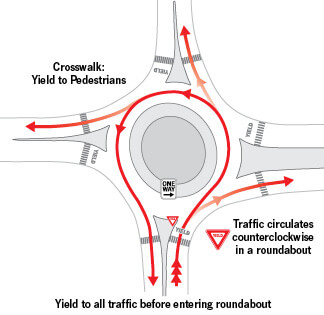13- Roundabouts
Roundabouts are becoming more common in the U.S. because they provide safer and more efficient traffic flow than standard intersections. Statistics show that roundabouts reduce fatal crashes by about 90 percent, reduce injury crashes by about 75 percent, and reduce overall crashes by about 35 percent, when compared to other types of intersection control.

This example shows the traffic movement patterns through a one-lane roundabout. The one-lane roundabout is known as one of the safest and most efficient intersections.
Lesson one – Driving in a Roundabout
- Slow down. Obey traffic signs and pavement markings.
- Yield to pedestrians and bicyclists.
- Vehicles entering must always yield to cars already in the roundabout. Look to your left for entering traffic.
- Enter the roundabout when there is a safe gap in traffic.
- Keep your speed low within the roundabout. Don’t stop, stay in lane once inside the
roundabout. The vehicle in the roundabout has the right of way. Do not change lanes within the roundabout. - As you approach your exit, look to your right, check your side mirror, and use your turn signal.
- Yield to pedestrians and bicyclists as you exit.
Lesson Two – Emergency Vehicles
- Always yield to emergency vehicles.
- If you have not entered the roundabout, pull over and allow emergency vehicles to pass.
- If you have entered the roundabout, continue to your exit, then pull over and allow emergency vehicles to pass.
- Avoid stopping in the roundabout.
Lesson Three – Two or More Lane Roundabouts
- As you approach the roundabout, it is very important to observe the signs and pavement markings to determine which lane to use before entering.
- Signs on the side of the road and white pavement markings on the road will show the correct lane to use.
- In general, if you want to make a left turn, you should be in the left lane or other lanes that are signed and marked as left turn lanes.
- If you want to make a right turn, you should be in the right lane or other lanes that are signed and marked as right turn lanes.
- If you want to go straight, observe the signs and pavement markings to see which lane is correct.
Yield the Right-of-Way
Commentary driving is a great communication tool. Coach your teen to describe their actions, thoughts and observations out loud as they drive, similar to a sports commentator. Throughout the learning process, ask them to verbalize what they see around them, including potential risks and any steps they need to take to avoid those risks. Encourage your teen to verbalize an action they plan to make, such as turning, merging and approaching traffic lights.